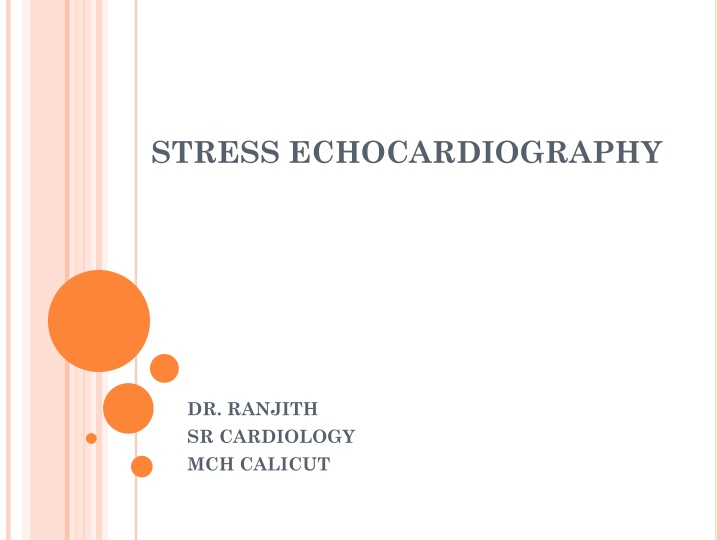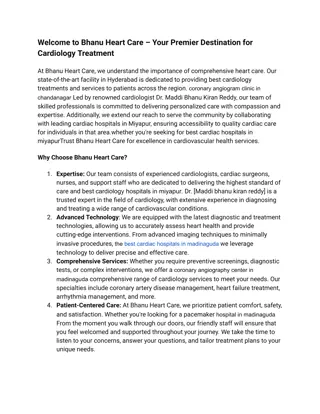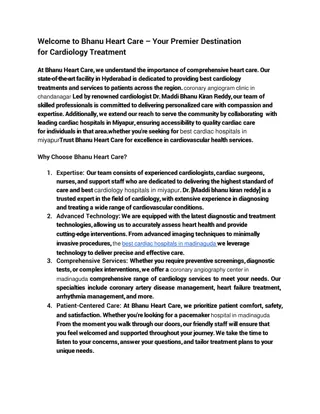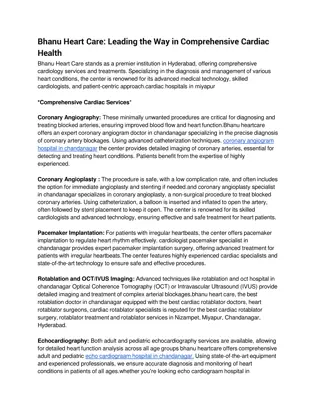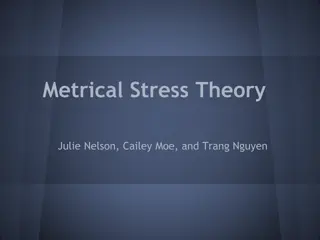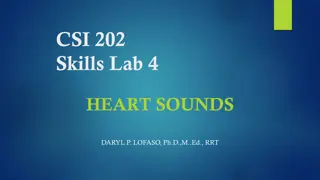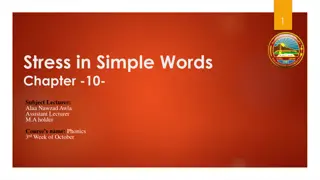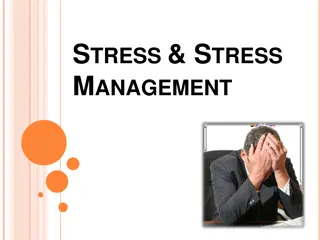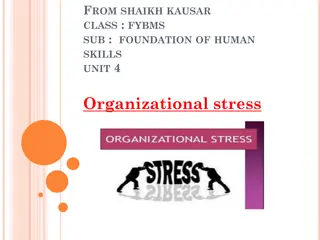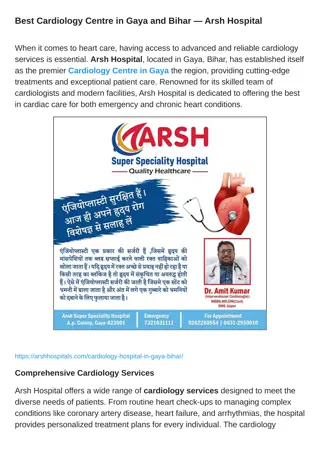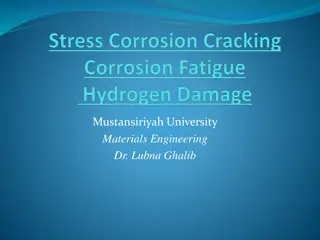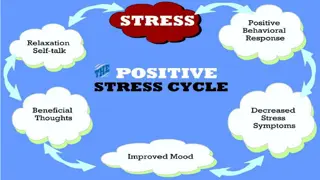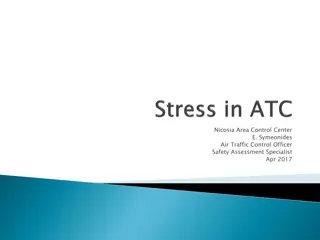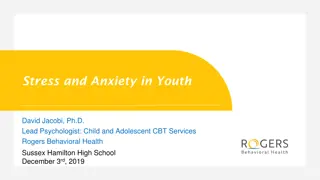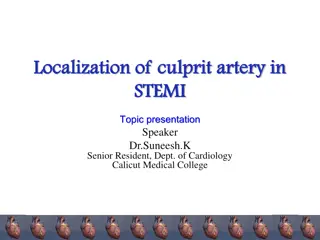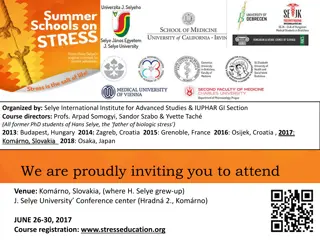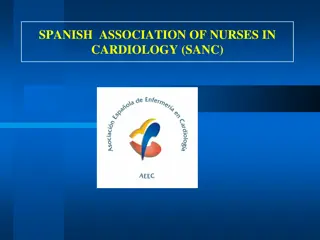Comprehensive Guide to Stress Echocardiography in Cardiology Practice
Stress echocardiography is a valuable tool in diagnosing and managing coronary artery disease, valvular heart disease, and assessing heart function. This imaging technique helps in detecting flow-limiting stenosis, understanding the ischemic cascade, and evaluating cardiac function during stress. Various stressors like exercise and pharmacological agents are used in different protocols for stress echocardiography. Understanding the indications and applications of stress echocardiography is crucial for accurate diagnosis and treatment planning in cardiology.
Download Presentation

Please find below an Image/Link to download the presentation.
The content on the website is provided AS IS for your information and personal use only. It may not be sold, licensed, or shared on other websites without obtaining consent from the author.If you encounter any issues during the download, it is possible that the publisher has removed the file from their server.
You are allowed to download the files provided on this website for personal or commercial use, subject to the condition that they are used lawfully. All files are the property of their respective owners.
The content on the website is provided AS IS for your information and personal use only. It may not be sold, licensed, or shared on other websites without obtaining consent from the author.
E N D
Presentation Transcript
STRESS ECHOCARDIOGRAPHY DR. RANJITH SR CARDIOLOGY MCH CALICUT
STRESS ECHOCARDIOGRAPHY Indication Coronary artery disease Valvular heart disease First line test in patients with baseline ECG abnormalities that preclude interpretation of exercise ECG
CORONARY ARTERY DISEASE Detection of CAD Localisation of coronary artery lesion Post MI- Risk assessment After revascularisation Viability assessment Preoperative evaluation
CORONARY ARTERY DISEASE Causal relationship between induced myocardial ischemia and left ventricular wall motion abnormalities Stress Increased HR and contractility increased myocardial blood flow hypercontractile response with increased EF
STRESS ECHO- CAD Most common application- Detection of flow limiting stenosis Based on sequence of events - Ischemic cascade Normal coronary arteries adapt to stress by coronary vasodilatation (coronary flow reserve) to meet the increased oxygen demand In the presence of flow limiting coronary stenosis- coronary flow reserve is impaired- resulting in ischemic cascade
ISCHEMIC CASCADE Chest pain ECG changes Ischemia Systolic abnormality Diastolic abnormality Perfusion abnormality Metabolic abnormality Duration
CADDETECTION Segmental wall motion abnormality- reduction in systolic thickening and endocardial excursion
TYPES OF STRESSORS EXERCISE STRESS NON EXERCISE STRESS Treadmill Dobutamine Supine bicycle Dipyridamole Upright bicycle Adenosine Handgrip Pacing Stair step
TREADMILL STRESS ECHO PROTOCOL Prepare patient Obtain rest echo images Perform standard TMT Pt moves as soon as possible after exercise to examination table. Post exercise images acquired and recorded Both set of images are compared
INFORMATIONOBTAINEDFROMEXERCISE STRESSECHO Exercise capacity Reproducibility of symptoms with activity Heart rate and BP response to exercise Detection of stress induced Arrhythmias Control of angina on OMT
EXERCISE STRESS ECHO TREADMILL Advantages Widely available Relatively simple protocols Preserves the additional information already available from TMT. Disadvantages Imaging is restricted to the immediate post exercise period. The ischemia may resolve quickly and hence the window for image acquisition is small. ( 1 to 1.5 minutes)
SUPINE BICYCLE ERGOMETRY Patient positioned on a supine bicycle ergometer with roughly 300 head up tilt. Rest images obtained Exercise started at a workload of 25 W and a cadence of 60 rpm. Workload is increased by 25 W every 2 minutes Images obtained throughout exercise and at peak exercise. After exercise images are obtained to look for normalization of WMA
SUPINEBICYCLE Advantage Imaging possible through out the exercise- especially peak exercise. Onset of RWMA Better image quality Applying contrast easier Disadvantage Lower work load acheivable Supine position affects exercise physiology
WHYPHARMACOLOGICALSTRESSECHO Hyperventilation Hypercontractility of Normal Walls Excessive Tachycardia Excessive chest wall movement Unable to exercise at all or maximally
DOBUTAMINE STRESS ECHO DOBUTAMINE A synthetic catecholamine Ionotropic and chronotropic effects Acts on 1 and 2 receptors Ionotropic effect at lower doses and more of chronotropic effect at increasing doses. Net effect is an increase in contractility, heart rate and myocardial oxygen demand
PROTOCOL FOR DOBUTAMINE STRESS ECHO Patient is prepared 4 hrs fasting All negative ionotropic and chronotropic agents held for 8 to 12 hrs. I.V access obtained. Baseline images obtained Continuous ECG and BP monitoring established Dobutamine infusion started @ 5 or 10 g/kg/min. Rate increased every 3 minutes to doses of 10,20,30 and 40 g/kg/min
Atropine can be given at a dose of 0.5 to 1.0 mg during mid and high dose stages -If THR not achieved -Max dose 2mg Peak images obtained just before termination of infusion. Post stress images obtained after return to baseline. Patient to be monitored till return to baseline. A trial dose of 50 g/kg/min maybe used if near THR achieved at 40.
DOBUTAMINEDOSECALCULATION 1 ampule = 5 ml 1ml= 50 mg 2 amp in 50 ml (500mg in 50 ml) 1 ml = 10 mg 5 mcg/kg/min= 5*60*60=18000 mcg=18 mg 5 mcg/kg/min= 2 ml/hr
Protocol for Dobutamine Stress Echo.
INDICATIONS TO TERMINATE DOBUTAMINE INFUSION DURING STRESS ECHO 1.Exceeding THR of 85% age predicted maximum. 2.Development of significant angina. 3.Recognition of a new wall motion abnormality. 4.A decrease in SBP > 20 mm Hg from baseline. 5.Sustained or symptomatic arrhythmias. 6.Limiting side effects or symptoms. 7.Severe HTN ( > 220/120 mmHG)
SAFETY Safety has been studied extensively Short t1/2 (2 minutes) -- induced ischemia readily reversed by termination of infusion. Severe cases - short acting i.v Blocker- Esmolol or Metoprolol can be used Overall rate of life threatening events- 1/1000 Freq complication- acute MI, VT, VF
LIMITATIONS False negative- suboptimal stress, limited image quality, small area of ischemia Challenging- LBBB, postoperative state, pacing other- HCM, cardiomyopathy, hypertension
OTHERPHARMACOLOGICALAGENTS Vasodilators Adenosine Dipyridamole
VASODILATOREFFECTONSTENOSED VESSEL
INTERPRETATION OF STRESS ECHO 17 segment model Normal ventricle-hypercontractile with stress and cavity size shrink HYPERKINESIS normal response to stress Lack of Hyperkinesis: - Myocardial ischemia - Non ischemic CMP. - Beta blocker therapy - Severe hypertension - Delay in image acquisition
VOLUMERESPONSE Decrease in ESV and EDV Normal response 25-30% decrease in ESV and EDV is the normal response. An abnormal volume response is defined as an increase in volume from rest to stress of > 17%.
CONTRASTECHO If endocardial resolution is poor in 2 or more segments- IV echo contrast enhancement
RWMA AT REST AT STRESS INFARCTION CARDIOMYOPATHY ISCHEMIA TRANSLATIONAL CARDIAC MOVEMENT MARKEDLY INCREASED BP CARDIOMYOPATHY RATE DEPENDENT LBBB PULMONARY HYPERTENSION MYOCARDITIS LBBB HYPERTENSION HIBERNATING MYOCARDIUM STUNNED MYOCARDIUM TOXINS POSTOPERATIVE STATE PACED RHYTHM RV VOLUME / PRESSURE OVERLOAD
WALLMOTIONRESPONSE Rest Normal Normal Akinetic Hypokinetic Hypokinetic Stress Hyperkinetic Hypokinetic/akinetic Akinetic Normal Akinetic/dyskinetic Interpretation Normal Ischemia Infarction Viable Ischemia/infarction
INTERPRETINGSTRESSECHO A largeischemic territory (left main or multivessel disease) -- diminished global LVEF and chamber dilation with stress
RISKSTRATIFICATION Patients who complete normal exercise or pharmacologic stress echo (reaching good exercise capacity and the target heart rate)-- the risk for cardiac events is very low and close to that of a normal population <1%/ year for exercise and <2% / yr for pharmacologic tests
ASSESMENT OF MYOCARDIAL VIABILITY The term viable refers to myocardium that has the potential for functional recovery. The resting Echo is neither sensitive nor specific The BIPHASIC RESPONSE -- augmentation at low dose followed by deterioration at higher doses is most predictive of the capacity for functional recovery. Any improvement in wall motion abnormality by at least one grade in two or more segments during stress is likely to signify viability
STRESS ECHO AFTER MI Used both to identify high and low risk subsets and to predict the location and extent of CAD. The goal is to identify ischemia at a distance Positive finding would be detection of a new WMA remote from the site of previous infarction. Inducible ischemia is a powerful indicator of high risk and suggests the need for further evaluation.
PREOPERATIVE RISK ASSESSMENT Most studies used dobutamine stress. Mainly before major peripheral vascular surgery and therefore included patients who frequently are unable to exercise. In this high-risk subset, the presence or absence of an inducible WMA has been the most potent determinant of relative risk. The absence of an inducible wall motion abnormality confers a very favorable prognosis, with a negative predictive value of 93% to 100%.
STRESS ECHO IN VALVULAR HEART DISEASE Aortic Stenosis The principal role of exercise testing is to unmasksymptoms or abnormal blood pressure responses in patients withAS who appear to be asymptomatic.
LOW FLOW LOW GRADIENT AS Anatomically severe AS and LV systolic dysfunction (EF<40%) often presents with a relatively low-pressure gradient, such as a mean gradient of 30 to 40 mm Hg or less
LOW FLOW LOW GRADIENT AS DSE can be used to assess both the true severity of AS and the amount of LV contractile reserve Dobutamine is infused in graded doses from 5 to 20 g/kg/min spectral Doppler of the LVOT and CW Doppler across the aortic valve SV is calculated from VTILVOT. An increase of 20% or higher in SV is indicative of significant contractile reserve. The test is indeterminate if little or no augmentation of LV function takes place (no contractile reserve, or SV <20%).
Aortic valve area is calculated at both baseline and with dobutamine True AS -- the ratio of aortic/LVOT velocity will increase Pseudosevere or functional AS- the LVOT and aortic gradients change relatively little, and the calculated valve area remains the same or increases
MITRALSTENOSIS Patients with mitral stenosis (MS) may have severe exertional symptoms despite relatively modest gradients on the resting echocardiogram. Conversely, sedentary patients with severe MS may be relatively asymptomatic because they are inactive. Valve gradients -- dependent on the flow rate and heart rate
MITRALSTENOSIS Stress echocardiography can define the true exercise capacity and quantitate the degree of valvular stenosis and regurgitation. A rise in the mean transmitral pressure gradient greater than 15 mm Hg or an increase in calculated pulmonary artery systolic pressure greater than 60 mm Hg is correlated with significant MS and consider BMV
MITRALSTENOSIS In asymptomatic patients with severe MS (mean gradient >10mm Hg and mitral valve area [MVA] <1.5 cm2) or Symptomaticpatients with moderate MS (mean gradient of 5 to 10 mm Hg andMVA > 1.5 cm2)
MITRALREGURGITATION In patients with MR --stress echo useful in revealing acute reversible ischemic MR caused by inferior wall ischemia usually associated with stress-induced inferior wall motion abnormalities and improvement in both abnormalities during recovery. In chronic severe MR, even if the LVEF is preserved, demonstration of a rise in PASP> 60mmHg with exercise and reduced LV contractile reserve -- indications for mitral valve surgery
OTHERINDICATIONS Hypertrophic cardiomyopathy exercise can bring out latent gradients and assess symptoms such as syncope Diastolic dysfunction Prosthetic valve gradient
